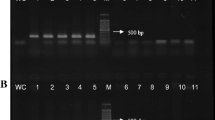Abstract
Pseudomonas savastanoi is a phytopathogenic bacterium causing severe disease on olive, oleander, ash, and other Oleaceae. Three main pathovars belong to this species: P. savastanoi pv. savastanoi, pv. nerii, and pv. fraxini. Detection methods are mostly based on the visual inspection of the typical symptoms (i.e., knots and galls). However, this bacterium can survive on the host plant also as an epiphyte without giving any symptom. To avoid the spread of P. savastanoi to areas where it is absent, it is necessary to develop efficient and sensitive detection methods. Here, we reported three different PCR-based techniques, able to discriminate the three P. savastanoi pathovars attacking woody plants.
Access this chapter
Tax calculation will be finalised at checkout
Purchases are for personal use only
Similar content being viewed by others
References
Gardan L, Bollet C, Ghorrah Abu M et al (1992) DNA relatedness among the pathovar strains of Pseudomonas syringae subsp. savastanoi Janse (1982) and proposal of Pseudomonas savastanoi sp. nov. Int J Syst Bacteriol 42:606–612
Ramos C, Matas IM, Bardaji L et al (2012) Pseudomonas savastanoi pv. savastanoi: some like it knot. Mol Plant Pathol 13:998–1009
Young JM (2004) Olive knot and its pathogens. Australas Plant Pathol 33:33–39
Cerboneschi M, Decorosi F, Biancalani C et al (2016) Indole-3-acetic acid in plant–pathogen interactions: a key molecule for in planta bacterial virulence and fitness. Res Microbiol 167:774–787
Tegli S, Bini L, Calamai S et al (2020) A MATE transporter is involved in pathogenicity and IAA homeostasis in the hyperplastic plant pathogen Pseudomonas savastanoi pv. nerii. Microorganisms 8:156
Añorga M, Pintado A, Ramos C et al (2020) Genes ptz and idi, coding for cytokinin biosynthesis enzymes, are essential for tumorigenesis and in planta growth by P. syringae pv. savastanoi NCPPB 3335. Front Plant Sci 11:1294
Quesada JM, Penyalver R, Pérez-Panadés J et al (2010) Dissemination of Pseudomonas savastanoi pv. savastanoi populations and subsequent appearance of olive knot disease. Plant Pathol 59:262–269
Quesada JM, García A (2007) Recovery of Pseudomonas savastanoi pv. savastanoi from symptomless shoots of naturally infected olive trees. Int Microbiol 10:77–84
Tegli S, Cerboneschi M, Libelli IM et al (2010) Development of a versatile tool for the simultaneous differential detection of Pseudomonas savastanoi pathovars by End Point and Real-Time PCR. BMC Microbiol 10:156
Surico G, Lavermicocca P (1988) A semiselective medium for the isolation of Pseudomonas syringae pv. savastanoi. Phytopathology 79:185–190
Azad Hamir R, Cooksey DA (1995) A semiselective medium for detecting epiphytic and systemic populations of Pseudomonas savastanoi from oleander. Phytopathology 85:740–745
Bella P, Licciardello G, Tessitori M et al (2008) A real-time PCR quantitative detection assay for Pseudomonas savastanoi pv. nerii in Nerium oleander. Phytopathol Mediterr 47:204–213
Penyalver R, García A, Ferrer A et al (2000) Detection of Pseudomonas savastanoi pv. savastanoi in olive plants by enrichment and PCR. Appl Environ Microbiol 66:2673–2677
Bertolini E, Olmos A, López MM et al (2003) Multiplex nested reverse transcription-polymerase chain reaction in a single tube for sensitive and simultaneous detection of four RNA viruses and Pseudomonas savastanoi pv. savastanoi in olive trees. Phytopathology 93:286–292
Glickmann E, Gardan L, Jacquet S et al (1998) Auxin production is a common feature of most pathovars of Pseudomonas syringae. Mol Plant Microbe Interact 11:156–162
Iacobellis NS, Caponero A, Evidente A (1998) Characterization of Pseudomonas syringae ssp. savastanoi strains isolated from ash. Plant Pathol 47:73–83
Gori A, Cerboneschi M, Tegli S (2012) High-resolution melting analysis as a powerful tool to discriminate and genotype Pseudomonas savastanoi pathovars and strains. PLoS One 7:e30199
Acknowledgment
This work was supported by INSTM with a grant to C.P. on a project coordinated by S.T.
Author information
Authors and Affiliations
Corresponding authors
Editor information
Editors and Affiliations
Rights and permissions
Copyright information
© 2022 The Author(s), under exclusive license to Springer Science+Business Media, LLC, part of Springer Nature
About this protocol
Cite this protocol
Tegli, S., Pastacaldi, C. (2022). Specific Detection of Pseudomonas savastanoi Pathovars: From End-Point PCR to Real-Time PCR and HRMA. In: Luchi, N. (eds) Plant Pathology. Methods in Molecular Biology, vol 2536. Humana, New York, NY. https://doi.org/10.1007/978-1-0716-2517-0_16
Download citation
DOI: https://doi.org/10.1007/978-1-0716-2517-0_16
Published:
Publisher Name: Humana, New York, NY
Print ISBN: 978-1-0716-2516-3
Online ISBN: 978-1-0716-2517-0
eBook Packages: Springer Protocols




